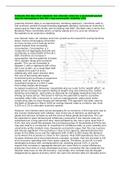Evaluate the idea that maintain low interest rates for a sustained period
may be damaging to the UK’s macroeconomic stability (25)
Lowering interest rates is an expansionary monetary approach, commonly used to
fuel economic growth through boosting aggregate demand, reducing an economy’s
output gap to trend rate levels, and increasing real GDP. The Bank rate is set by the
Monetary Policy Committee which currently stands at 0.1%, and can influence
fluctuations to an economy’s stability.
Low interest rates can catalyse economic growth as the reward for saving becomes
lesser, hence encouraging consumers
to move money out of savings and to
spend instead, thus increasing
consumption. Consumption is a
component of aggregate demand and
contributes to around 60% of the UK’s
GDP, therefore an increase in
consumption has the potential to boost
AD in tandem along with economic
growth. This can be illustrated in
diagram 1 with a rightward shift of the
AD curve to AD1, as a result Real GDP
increases from point Q to Q1.
Additionally with lower interest rates
the cost of borrowing decreases,
incentivising the purchase of expensive
assets, such as housing or larger
investment projects in a firm’s case.
This further boosts AD through
increased investment. Moreover, households who succumb to the ‘wealth effect’, as
asset prices increase the owners feeling of wealth may also enhance this, further
boosting consumption, particularly as demand for mortgage ownership rises thus
driving up house prices. This boost in AD has the potential to lead to a positive
multiplier effect with a reduction in cyclical unemployment, particularly within
construction jobs as more houses are demanded. This approach has been used by
the Bank of England in March 2020 by cutting interest rates to a historic low, from
0.25% to 0.1% to stimulate economic growth.
However, low interest rates can be damaging for an economy in the long term due to
the inverse relationship with inflation. Due to the law of demand, as demand for
goods and services increase so will the price of those goods and services. This can
be expected to spark demand pull inflationary pressures if low interest rates are
sustained over a long period of time, demonstrated by the rise in price level from P
to P1. Not only would this dampen the purchasing power of households and firms but
may also lead to a contraction in investment if confidence falls, as price volatility and
uncertainty within markets rises. Keynesian economists argue that this rise in prices
will only be significant if an economy is close to full capacity, demonstrated by the
shape of the SRAS curve and the rightward shift of AD1 to AD2 along the demand
curve where this economy is closer to full capacity. Real GDP experiences less of an
increase whereas price level experiences a greater increase, than the increase in AD
of an economy operating with more spare capacity. Therefore, as the UK is a well-
developed economy with unemployment low, standing around 4.5%, it can be
argued that increases in aggregate demand are more likely to cause inflationary
pressures, than that of a less developed economy, increasing the risk sustained low
interest rates have on the UK economy. Conversely, this concept may be thought
disapproved by Japans economy which has seen low interest rates for decades and is




